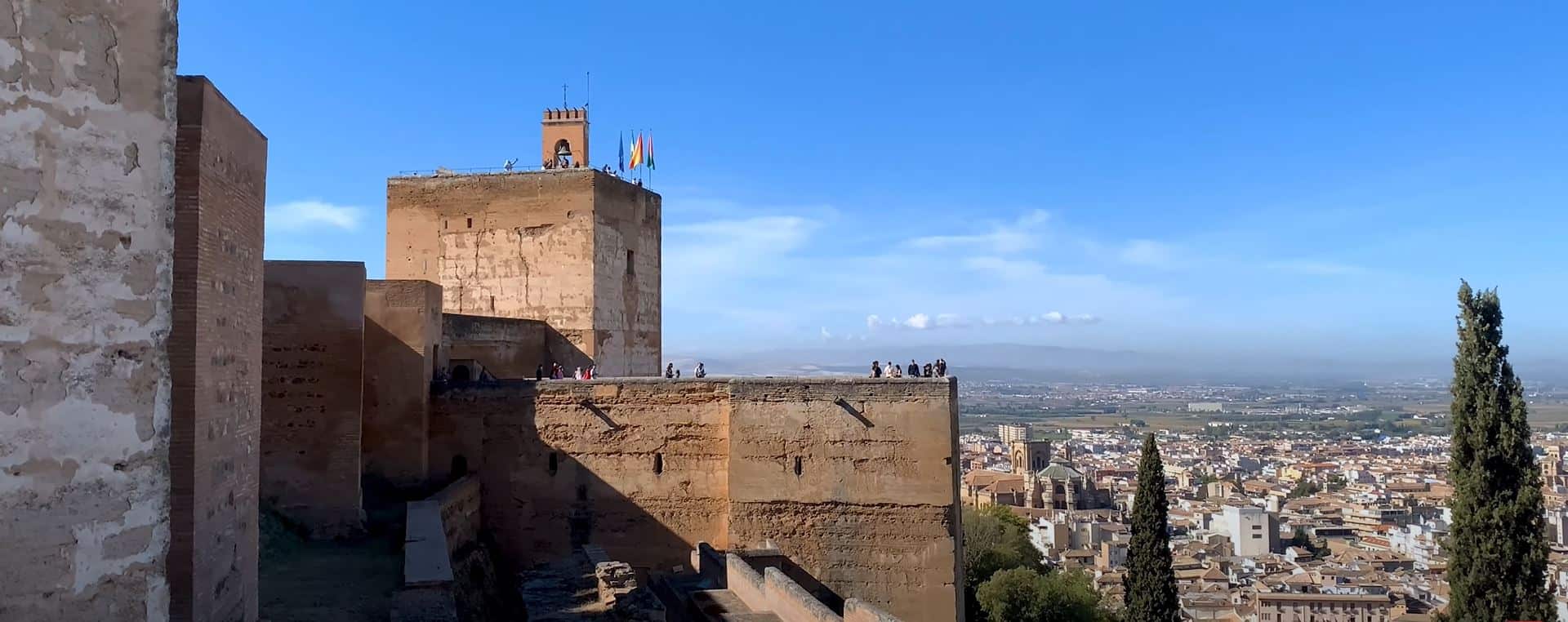Alhambra | Andalusia, Spain

Updated On: February 25, 2024 by Ahmed Samir
In the heart of Andalusia, Spain, a mesmerizing architectural masterpiece known as the Alhambra stands as a living testament to the rich tapestry of human history, artistic ingenuity, and cultural fusion. The name “Alhambra” evokes images of an enchanting palace complex nestled amidst the rolling hills of Granada, beckoning travellers and history enthusiasts alike to explore its labyrinthine corridors, lush gardens, and captivating courtyards.
This article invites you to embark on a fascinating journey through time and space, unravelling the enchanting story of the Alhambra, an iconic symbol of Andalusia’s multifaceted heritage and the enduring legacy of Moorish civilization. Within these walls, one discovers architectural wonders and the echoes of centuries past, where Islamic artistry, European influence, and the spirit of coexistence converge to create an unparalleled cultural treasure.
The Alhambra’s Rich Heritage
The Alhambra’s history is a tapestry woven with threads of different cultures and civilizations. It was initially constructed as a small fortress in 889 AD by the Berber ruler Sawwar ben Hamdun and situated atop a hill overlooking the city of Granada. The strategic location of the fortress allowed for easy surveillance of the surrounding lands.
The fundamental transformation of the place began in the mid-13th century when the Nasrid Dynasty took control of the region. Under the rule of Muhammad I, the fortress was expanded into a palace complex, and its distinctive Islamic architectural features started to emerge. Over the next century, the Nasrid Dynasty developed the Alhambra into a breathtaking palace with gardens, courtyards, and intricate tilework.
However, the glory of the Nasrid Dynasty was short-lived, as in 1492, the Catholic Monarchs, Ferdinand and Isabella, conquered Granada and the Alhambra. This marked the end of Islamic rule in Spain and the beginning of a new chapter for the Alhambra. Despite the change in ownership, the Catholic Monarchs recognized the architectural and cultural significance of the Alhambra and worked to preserve its beauty.
Architecture and Design
The Alhambra is renowned for its exquisite Islamic architecture, characterized by intricate geometric patterns, stunning tilework, and graceful arches. The complex is divided into several distinct sections, each offering a unique architectural experience:
- Nasrid Palaces: The heart of the Alhambra, the Nasrid Palaces, are a masterpiece of Islamic design. The Palacios Nazaríes have three interconnected palaces: the Mexuar, the Comares Palace, and the Palace of the Lions. These palaces are adorned with intricate stucco work, delicate arabesques, and colourful tiles. The famous Court of the Lions, with its central fountain supported by twelve marble lions, symbolizes the Nasrid Dynasty’s grandeur.
- Generalife: Located adjacent to the Nasrid Palaces, the Generalife is a set of lush gardens and leisurely retreats. It features terraced gardens, pavilions, and refreshing water features, offering a serene contrast to the opulence of the palaces. The Generalife is a testament to the Nasrids’ appreciation for the natural world and their desire for harmony with nature.
- Alcazaba: The Alcazaba is the oldest part of the Alhambra, built initially as a fortress. Its towers and walls offer panoramic views of Granada and the surrounding countryside. The Torre de la Vela, one of the towers in the Alcazaba, provides an excellent vantage point from which to admire the beauty of the Alhambra.
- Charles V Palace: Commissioned by Emperor Charles V in the 16th century, this Renaissance-style palace starkly contrasts the Moorish architecture of the place. Its circular courtyard and grandeur reflect the changing times and the fusion of different regional architectural styles.
Art and Decoration
The Alhambra’s interior spaces are adorned with intricate decorations that leave visitors in awe of the craftsmanship and artistic vision of the Nasrids. The primary creative elements that define the Alhambra’s beauty include:
- Stucco Work: The Nasrid artisans were masters of stucco work, creating intricate patterns and designs that adorn the walls and ceilings of the palaces. The stucco is often carved with geometric shapes and Arabic calligraphy, adding depth and texture to the interiors.
- Tilework: The place is famed for its vibrant tilework, featuring intricate ceramic tile mosaics known as azulejos. These tiles create stunning geometric patterns and colourful scenes that evoke the natural world.
- Arabesques: The Alhambra’s architecture is rich in ornate arabesques, intertwined designs inspired by natural elements such as vines, leaves, and flowers. Arabesques can be found in stucco work, tilework, and woodcarvings throughout the complex.
- Calligraphy: Arabic calligraphy is integral to the Alhambra’s decorative scheme. Inscriptions from the Quran and Nasrid poetry adorn the walls, adding spiritual and cultural significance to the palace.
The Enduring Impact of the Alhambra
The place is not merely a beautiful palace complex; it symbolizes Andalusia’s multicultural heritage and is a testament to the coexistence of different regional cultures. Over the centuries, the place has played various roles, serving as a royal residence, a military fortress, and a cultural centre. Its enduring cultural significance is reflected in several ways:
- Architectural Influence: The Alhambra’s architectural style has left an indelible mark on the region, influencing later Spanish and European architectural movements. Moorish design elements can be seen in numerous buildings and structures throughout Andalusia.
- Literary Inspiration: The Alhambra has inspired countless writers, poets, and artists. Washington Irving’s collection of essays and stories titled “Tales of the Alhambra” is one of the most famous works inspired by the palace complex.
- UNESCO World Heritage Site: In 1984, the Alhambra was designated a UNESCO World Heritage Site, recognizing its cultural and historical significance. This status has helped ensure the preservation and conservation of the site for future generations.
- Tourism and Education: The place attracts millions of visitors annually, making it one of Spain’s most popular tourist destinations. It serves as an educational experience for those interested in the history and culture of Andalusia.
Visiting the Alhambra
A visit to the place is a journey through time and a chance to immerse oneself in the beauty and history of Andalusia. Here are some practical tips for planning your visit:
- Ticket Reservation: Due to its popularity, booking your tickets in advance is advisable, especially during peak tourist seasons. Tickets can be purchased online or at the ticket office near the entrance.
- Guided Tours: Consider taking a guided tour to gain a deeper understanding of the history and significance of the Alhambra. Knowledgeable guides can provide valuable insights into the complex’s architecture and culture.
- Time of Visit: Plan to visit early in the day or later in the afternoon to avoid the crowds and enjoy a more peaceful experience. The early morning light also enhances the beauty of the architecture.
- Comfortable Attire: Wear comfortable shoes, as much walking is involved. Additionally, dress modestly out of respect for the cultural and historical significance of the site.
- Photography: Photography is allowed in most areas of the Alhambra, but flash photography is generally prohibited inside the Nasrid Palaces. Be sure to check the specific rules in place during your visit.
Conclusion
The Alhambra is a shining jewel in the crown of Andalusia, Spain. Its rich history, breathtaking architecture, and cultural significance make it a must-visit destination for travellers worldwide. The fusion of Moorish, Spanish, and European influences within its walls encapsulates the spirit of coexistence and cultural exchange that has shaped the region for centuries. A visit to the place is a journey through history, a profound exploration of human creativity, and the enduring power of art and architecture. It is a testament to the idea that the beauty of the past can continue to inspire and enrich our lives in the present.
FAQs
What steps are taken to preserve and protect the Alhambra’s historical and cultural significance?
The Alhambra is a UNESCO World Heritage Site, and extensive efforts are being made to conserve its beauty and historical value. These efforts include restoration projects, strict conservation guidelines, and ongoing maintenance.
Are guided tours available for visitors to the Alhambra?
Yes, guided tours are available and highly recommended for a more in-depth understanding of Alhambra’s history and architecture. Knowledgeable guides provide valuable insights during the visit.
How did the Catholic Monarchs impact the Alhambra after their conquest of Granada?
After their conquest in 1492, Ferdinand and Isabella recognized the architectural and cultural significance of the Alhambra. They preserved its beauty and added elements of Christian architecture to some parts, such as the construction of the Charles V Palace within the complex.
What cultural influences can be seen in the Alhambra’s design?
The place reflects a blend of Islamic, Spanish, and European influences. Its intricate tilework, stucco decorations, and arabesque patterns showcase the Islamic heritage, while the Charles V Palace demonstrates Renaissance European influence.
How did the Catholic Monarchs impact the Alhambra after their conquest of Granada?
After their conquest in 1492, Ferdinand and Isabella recognized the architectural and cultural significance of the Alhambra. They preserved its beauty and added elements of Christian architecture to some parts, such as the construction of the Charles V Palace within the complex.






